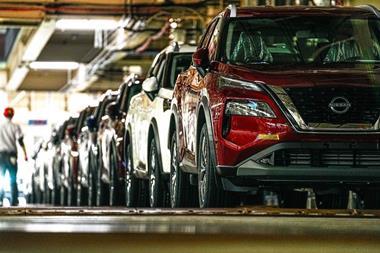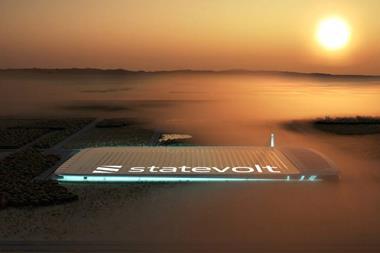
In October this year, General Motors will celebrate the 100th anniversary of Chevrolet. Wayne Brannon, President of Chevrolet Europe, explains how the brand plans to increase its presence in the region, and looks at the future of Opel and Vauxhall
After a period of upheaval for General Motors’ European operations that saw the business separated into two distinct units, the company has entered a new phase – ambitious growth with a timetable towards solid profitability.
Opel-Vauxhall will remain the volume division, but there are plans to steadily push the brand slightly upmarket of where they now sit in the European market mix.
If General Motors’ vision is realised, Opel-Vauxhall cars will one day command the same price premium as Volkswagen models, leaving room for Chevrolet vehicles to follow suit in the same way that has happened with Škoda over the last decade. But can it work? And where do such plans leave models like the Camaro and Corvette sports cars, or indeed the Volt extended-range saloon?
Further, there is the question of manufacturing. Currently, the majority of Chevrolet vehicles are imported into the European region, so will we see Chevy cars coming down the line at Opel-Vauxhall plants? AMS interviewed Wayne Brannon, President of GM Europe, to find out more.
AMS: We’re continuing to see a lot more new model launch activity from Chevrolet Europe than even 12 months ago. Why is this happening, when the overall market is comparatively flat?
Wayne Brannon: We’ve just launched the new Cruze fivedoor hatchback, which gives us a strong product in one of the largest segments. On average across Europe - and I’m not talking about specific countries - this segment is about 65% hatch, 30% wagon and 5% sedan. We launched the sedan first and last year we grew our share of that segment with just the four-door car, to 59,000 vehicles. So now we are launching right into that 65% and we are very optimistic that the Cruze hatch can get a reasonable share of the overall volume.
AMS: Would you put a sales number on Cruze five-door?
WB: I’d be more comfortable to tell you that number this time next year! The issue is that we have the hatch being launched in September, so it’s obviously only part-year for 2011 but let’s see about maybe two, three, maybe four per cent of the segment as what I think we could do. It’s a big, big opportunity for us in Europe, this car.
If you look at Spark, our A-segment car, which we launched at the start of 2010, we sold 77,000 cars last year.
Now that was a lower number than we had hoped, due to that segment shrinking across the region. The reason for that was the end of scrappage schemes, particularly in Germany and in other major markets. But the good news is that we gained segment share. So it’s a good indication that as we continue to launch new from-the-ground-up models, each one will be well received.
In his capacity as President and Managing Director of Chevrolet Europe, Wayne D. Brannon leads a pan-European organization responsible for marketing a range of small to medium sized Chevrolet passenger vehicles. Prior to this appointment, which he took up in January 2006, Brannon was responsible for sales and marketing at General Motors Latin America, Africa and Middle East.
 Brannon, who is from the Detroit area, holds a Bachelor of Industrial Administration degree from the General Motors Institute (GMI), now Kettering University. He was later awarded a GM Fellowship to attend Michigan State University, where he earned a Master of Business Administration degree in 1983.
Brannon, who is from the Detroit area, holds a Bachelor of Industrial Administration degree from the General Motors Institute (GMI), now Kettering University. He was later awarded a GM Fellowship to attend Michigan State University, where he earned a Master of Business Administration degree in 1983.
Even while he was a co-op student attending the General Motors Institute, Brannon began his career with the carmaker. Starting at the Cadillac Motor Car Division in 1973, he went on to spend 15 years with the division in various field and central office positions within sales, marketing and planning. He then moved to the GM Corporate Marketing and Planning department where he was appointed consumer research manager and, two years later, manager of North American market analysis. In 1992, Brannon became director of sales and marketing for Africa, going on to lead various sales and marketing activities there and also in the Middle East and South America.
Brannon previously served as vice-president of General Motors Overseas Distribution Corporation, vice-chairman of the US Corporate Council on Africa and board director of the African Business Roundtable.
AMS: Would you expect the Cruze five-door to become the brand’s new best seller across Europe?
WB: I can tell you what’s happened in the past. In Europe, the B-segment and the C-segment have often been competing to be the biggest. Now in our case, our entries in those segments, the Aveo in the B-segment and the Lacetti and Nubira in the C-segment have all been replaced, so we have fresh products and the ability to compete more strongly than we might have done in the past, with those older products.
I also want to say this. Aveo was our number-one selling car and yet we didn’t have a diesel engine in that car (oldshape model, replaced earlier in 2011). Diesel is about 53 or 54% of the B-segment and starting from the end of this year, we will have a diesel in the new Aveo and that will probably become our new number one seller. But let’s see, maybe the Cruze will be. Either way, it’s great to have such strong products in both those segments. We will have to see what our customers decide.
We have been very fortunate to be one of the fastestgrowing brands in Europe. Since 2005, we have doubled our volumes. In 2008, we sold 508,000 cars and then we sold 477,000 cars last year, so big growth from the days when GM was selling the Daewoo brand in Europe, which as you know, was the predecessor brand to Chevrolet in this region. In fact, in 2010, we had record market share in 21 countries in Europe, so we are moving in the right direction.
AMS: The Volt, which we know goes on sale in Europe at the end of the year, will be a niche vehicle, but what other plans does Chevrolet have for low-emissions powertrains?
WB: We are working very hard to improve the performance of our gasoline engines and our diesel engines. For example, with the new diesel that we’re launching in the Aveo. With stop-start technology, we expect to be under 100 grams of CO2 emissions.
We will announce some hybrid applications, some new battery-electric applications and more extended-range electric vehicles. I can’t say we are going to launch all of them in Europe but the beauty of this for Chevrolet is that we now have a uniform product portfolio, so we adapt the powertrains and the offer [available] for markets all around the world. We will have some of what I would call these ‘ecologic’ cars in the future, for Europe.
But it’s not just low emissions technology; we have to have a real standout performer in segments where we participate.
AMS: How does that low-emissions philosophy sit with your high performance models?

WB: If you look at the pillars of our brand and say you asked 100 consumers in Europe what they think Chevrolet means, 85% would say it’s an American car company. So we’re thought of as having a heritage that means the Corvette or the Camaro or some of the SUVs that we brought over from North America. And yet we sell more cars outside the US than we do inside it, and we sell our cars in 130 countries.
Now if you think about it, we are the only brand of any volume that has that distinction, and we like the connection to American pop culture that we have.
The big issue for us is to keep telling people that we have cars that are more fuel efficient, or maybe smaller than what they might be thinking, or more practical. Chevrolets are designed for European consumers and as brand awareness rises, as we have seen, so do our sales – dramatically - as they have done in recent years. So we just need to keep telling people about us and getting them to consider our models.
 AMS: How do you see the European market in 2011 and Chevrolet’s sales?
AMS: How do you see the European market in 2011 and Chevrolet’s sales?
WB:Well, I don’t think we’ll see us going too far from where we ended 2010. We may be a little better but the market is a challenging one with sales down in so many countries. The great news for us is that we will have launched seven new models by the end of 2011, though some of those cars won’t be here until the last part of the fourth quarter. The only new car will we have for the full year is Orlando and in many markets we are sold out, so we underestimated the demand for that vehicle.
I think for 2012, the question is can we make progress from that half a million level and head towards the goal we have set of a million vehicles a year over the medium term.
AMS: The majority of your production comes out of GM Korea. Is there any reason why you can’t get cars out of GM plants in St. Petersburg [Russia] or Uzbekistan?
 WB: We aren’t building cars in those two countries that are compliant with European regulations. But even if we did - and by that I just mean that there are particular EC regulations which Russia and Uzbekistan don’t share at present – we can’t build enough cars for those countries, let alone think about shipping cars from there to Europe. There are capacity issues that we are trying to solve, and we can do that by working with contract assemblers to some extent. But looking to Russia and other nearby markets for extra cars for Europe, that wouldn’t be the solution.
WB: We aren’t building cars in those two countries that are compliant with European regulations. But even if we did - and by that I just mean that there are particular EC regulations which Russia and Uzbekistan don’t share at present – we can’t build enough cars for those countries, let alone think about shipping cars from there to Europe. There are capacity issues that we are trying to solve, and we can do that by working with contract assemblers to some extent. But looking to Russia and other nearby markets for extra cars for Europe, that wouldn’t be the solution.
In the longer term, we won’t have a capacity issue with Korea. In the short term, the issue that we have is planning and allocation of cars. We told them that we are going to sell ‘X’ number of vehicles – Orlando, for example – and now we need more than that, so that’s where the problem has been.
So we’re working with GM Korea to resolve that. I’m a car salesman from Detroit, so you know, right now, if I could get more cars, I would take them because I know we can sell them!

AMS: Will you continue to rely on GM Korea’s plants for the majority of your future products?
WB: Our main models, our high-volume models, all come from Korea. We have a few niche products, the Camaro and Corvette, plus soon we will have the Volt too – these are sourced from North America. We do look at other global locations for our products, but for now there is enough capacity from GM Korea to service our sales capacity, as well as our immediate growth objectives.
 AMS: Earlier this year there were some discussion in Germany surrounding comments made by the plant manager at the Opel-Vauxhall plant at Bochum, who wanted to see GM build Chevrolet products there.
AMS: Earlier this year there were some discussion in Germany surrounding comments made by the plant manager at the Opel-Vauxhall plant at Bochum, who wanted to see GM build Chevrolet products there.
WB: The way we work, we have a global manufacturing organisation that constantly looks at our manufacturing footprint. I cannot comment on that particular example. To put it simply, I say “I need these cars” and right now, 99% of them come from Korea.
AMS: If not Germany, then maybe another Eurozone market? Surely the issue of building and selling cars in the same currency is an attractive one for Chevrolet Europe?
WB: I’m not in the business of buying and selling currencies, and also, the main activity of Chevrolet Europe is not manufacturing. But I can tell you this: Chevrolet Europe has been a profitable company for the last four years. How many other companies can say that, given what we’ve been through with the financial crisis?
AMS: How has your division of GM been able to make money, especially in the context of the large losses rung up by Opel and Vauxhall in recent years?
WB:We have decent margins and a spending and a cost plan that fits our margins. It’s about managing the business.
AMS: Have you been lucky with hedging, perhaps?
WB: No. Look, we don’t have a lot of costs for our business.
We have our people, we have a few offices, we have some parts warehouses, we have advertising and promotion. We don’t have manufacturing costs. I buy the cars from the plants and I re-sell them to our dealers. So we basically just have to manage those structural costs.

AMS: Could you explain how you’re planning to sell the Volt, given that Europe hasn’t seen a product like this before?
WB: We’re not going to sell it through all of our sales networks, and we’re going to start off by concentrating on major cities. So a small number of dealers and not a large volume of cars. We are going to focus the car towards those buyers who are looking for new technology. And the reality is, with the price point being high as it is for all electric cars, at first we won’t be selling a great number of these cars.
 But after the first group of early adopters buys the Volt, and people start to learn about the technology and see that unlike pure electric cars, that this can be their only car, then we expect the sales momentum to start rising.
But after the first group of early adopters buys the Volt, and people start to learn about the technology and see that unlike pure electric cars, that this can be their only car, then we expect the sales momentum to start rising.
AMS: How will it be for Chevrolet to be competing with the Opel and Vauxhall Ampera, which is more or less the same car?
WB: Not at all. The thing to look at is the technology, and the technology offers the consumer something new and innovative. It works, the idea of the range extender as a back up to the car’s batteries has a lot of appeal. And remember, we have different customers in Europe. We have very little overlap between Chevrolet and Opel-Vauxhall. The interaction between the Volkswagen brands is higher than it is between the General Motors brands in Europe. The same applies to the PSA brands. So whenever we look at secondchoice data or repurchase intentions, we have almost no interaction.
You know, 91% of the market out there is somebody else other than a General Motors brand. That means that whatever we do typically impacts another brand a lot more than it does another GM Europe brand. I see this issue of competition between GM brands in this region raised now and then, but honestly, it isn’t an issue for us, it’s low on our totem pole. I mentioned that Chevrolet Europe grew in 21 markets last year. Opel grew in 18 markets. We’re winning together; we’re not winning one over the other.
Future analysis: Opel and Vauxhall
Chevrolet Europe, which is run as a separate business from Adam Opel and Vauxhall Motors, has been comparatively isolated from the speculation surrounding the possible sale of the other two companies, including German- and UK-based elements of GM’s European business.
With Opel-Vauxhall having posted a profit in the first quarter of 2011, the rumours of a sale to unknown buyers surrounded the division for months before such speculation started to die down. In August came word from GM’s CEO Dan Akerson, who simply stated, “Opel is part of our global reach - it is not for sale. End of discussion.”
The speculation is thought to have been started by two German publications, which sought to ascertain just what plans GM had for the future of the Bochum plant that currently builds the Zafira MPV and will shortly begin building the new Zafira Tourer.
In addition to having posted a profit in Europe for the first quarter of 2011, Opel also increased market share for the seventh month in a row, based on year-on-year figures.
And while 2011 has seen much new product for Chevrolet in Europe, Opel is about to start gaining the much-needed new models that will tempt buyers in Germany and other European countries as markets continue to slowly improve.
First up in terms of new vehicles for the second half of 2011 will be the third-generation Zafira. This model, the Zafira Tourer, is both larger – and more expensive - than the current model. Both second- and third-generation models will be built alongside one another for a period, the idea being to ease buyers towards thinking of newer Opel and Vauxhall models as more premium and direct rivals for the equivalent Volkswagen in their segment.
 The same thinking will apply to the new Opel and Vauxhall ‘Junior’, a small car that could still be produced using the ‘Allegra’ model name. Whatever the case, this city car, which is due for launch in 2013, will take the brands into the pricing class that is presently dominated by the Fiat 500.
The same thinking will apply to the new Opel and Vauxhall ‘Junior’, a small car that could still be produced using the ‘Allegra’ model name. Whatever the case, this city car, which is due for launch in 2013, will take the brands into the pricing class that is presently dominated by the Fiat 500.
The Allegra/Junior will effectively be a rebodied variant of the next Opel and Vauxhall Agila, the present generation of which is built by Suzuki. Both the Junior/Allegra and the next Agila are being developed by Opel.
At the other end of the model range, Opel is planning a premium-priced, large model that would sit above the current Insignia. Further, there will be other additional vehicles, such as a small SUV/crossover, plus another car to be powered by an evolution of the Voltec powertrain as used by the Ampera and Chevrolet Volt extended range EVs.
Karl-Friedrich Stracke, who heads up Opel, recently told the German media that he also wants to push the brand into many new markets outside its traditional European base. He sees a potential for an additional up to 150,000 sales worldwide, which would come from relaunching the brand in China and other high-growth markets, as well as entering new countries, such as Australia.
That extra volume would go a long way towards improving production utilisation at Opel and Vauxhall plants, though any new, additional vehicles for GM Europe’s core brands could be just as likely sourced out of plants in Korea, Australia, Canada or the United States.
As for the question of when more Chevrolet vehicles might be made in Europe, this was answered by GM’s Dan Akerson in August. Speaking at an analysts’ meeting in Detroit, the company’s CEO reportedly stated, “We need probably to start manufacturing Chevrolets in Europe at some point in time. That’s on the strategic ‘What should we do?’ list.”


































